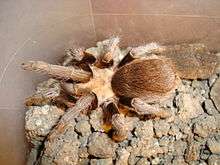Texas brown tarantula
| Texas brown tarantula | |
|---|---|
 | |
| Scientific classification | |
| Kingdom: | Animalia |
| Phylum: | Arthropoda |
| Subphylum: | Chelicerata |
| Class: | Arachnida |
| Order: | Araneae |
| Infraorder: | Mygalomorphae |
| Family: | Theraphosidae |
| Genus: | Aphonopelma |
| Species: | A. hentzi |
| Binomial name | |
| Aphonopelma hentzi (Girard, 1852) | |
| Synonyms[1] | |
| |
Aphonopelma hentzi, the Texas brown tarantula, (also known as Oklahoma brown tarantula or Missouri tarantula),[2] is one of the most common species of tarantula thriving in the southern-most United States today. Texas brown tarantulas can grow in excess of a four inch leg span, and weigh more than 3 ounces as adults. The body is dark brown. Shades may vary between individual tarantulas and are more distinct after a moult.
Life cycle
Female A. hentzi can lay up to 1,000 eggs. The eggs are positioned securely in a web, which remains in the tarantula burrow, and guarded by the female. Eggs hatch in 45 to 60 days. Once spiderlings leave the egg sac, it is not unusual for them to stay with the females for up to a week or possibly longer before dispersing to make their own burrows.
Females have been known to live up to 30 years. But considering no studies have lasted so long, the lifespan is presumed to be longer. Males rarely live over 1 year after they have matured.
Habitat
A. hentzi lives in North America throughout Arkansas, Texas, Oklahoma, southern Kansas and Missouri, and northwestern Louisiana and other adjoining areas in the U.S. and Northeast Mexico.[2][3] The spider can also be found in Colorado, and has been observed as far north as Denver.[4] They are commonly found in grasslands, burrowed under ground; or using logs, stones, or other small animals' abandoned dens as their home and feeding grounds. Texas brown tarantulas will use their spinnerets to line the entrance of their shelter with webbing so as to detect passing prey. Tarantulas are often restricted to the ground but can climb.
Food
In captivity, the diet of a Texas brown tarantula consists primarily of cockroaches, crickets, and the occasional beetle larvae (mealworm/superworm). Pinky mice are unhealthy for tarantulas and therefore should not be fed. When feeding beetle larvae or crickets, be sure to remove them after a day as both have been known to chew holes in molting spiders. It is important not to overfeed a tarantula, especially young tarantulas, as this causes their organs to not form properly and thus cutting their life short. During a large feeding, the abdomen (opisthosoma) will often increase in size by two-fold.
If overfeeding is suspected or observed (it will look abnormally big and shiny), allow the tarantula as much time as it takes for its swollen abdomen to decrease in size, even if it takes months, by not offering any food during this time period.
Pets
Texas brown tarantulas are very common as pets because of their docility. Like many other popular pet tarantula species (see: Mexican redknee tarantula), Texas brown tarantula are easy to handle, very low maintenance, and inexpensive to care for. Habitats should be kept in a terrarium with low humidity and the surrounding temperature set to 68-86 °F. The length should be wider than twice the leg-span of the tarantula, and should include shelter for hiding and sleeping while inside the terrarium.
Recommended feeding includes four to six live crickets every few weeks. Gut loading, or providing prey with vitamins and other nutrients, provides tarantulas with a healthy meal. Uneaten prey should be removed after one day. Fasting, or not eating, for days or weeks at a time is sometimes an indication of an upcoming molt. A water dish should be supplied and maintained, shallow enough for the tarantula to drink from.
Defense
When disturbed, like most other tarantulas, the Texas brown will maneuver itself to a stance on its hind legs and raise its front legs in a threatening manner. Also, Texas brown tarantulas have small coarse brown and/or black urticating hairs on their abdomen that they will kick in the direction of whatever they may feel threatened by. Bites from the Texas brown tarantula are generally not a serious harm to humans. Apply a cold compress to the area, and if swelling or a rash occurs, seek medical attention.
See also
References
- ↑ Hamilton, C.A.; Hendrixson, B.E. & Bond, J.E. (2016), "Taxonomic revision of the tarantula genus Aphonopelma Pocock, 1901 (Araneae, Mygalomorphae, Theraphosidae) within the United States", ZooKeys, 560: 1–340, doi:10.3897/zookeys.560.6264
- 1 2 "Spiders: Tarantula". University of Missouri. 1993–2011. Retrieved January 21, 2011.
- ↑ "Redefining the Type Locality and Range of the Tarantula, Aphonopelma hentzi". Aphonopelma: Tarantulas of the United States. August 9, 2010. Retrieved January 21, 2011.
- ↑ Aphonopelma hentzi (Girard 1852), female, Denver, Colorado, USA - Tarantulas, Bird Spiders - Rick West, Arachnologist
- Marshall, Samuel D. (2001). Tarantulas and Other Arachnids. Barron's. ISBN 0-7641-1463-8.
External links
| Wikimedia Commons has media related to Aphonopelma hentzi. |